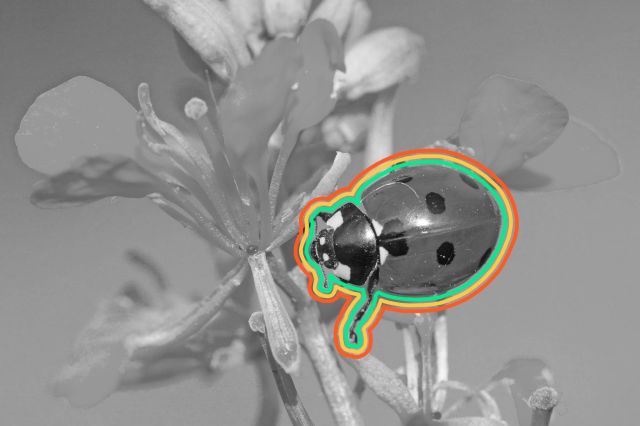
Ants Can Carry 10 to 50 Times Their Body Weight
Estimates vary on how much hardworking ants can actually carry, but the consensus is that it’s a lot — anywhere from 10 to 50 times their own body weight. They’re so tiny that their muscles are thick compared to their body size, leading to a disproportionate amount of strength for their size. One 2014 study suggests that an ant’s neck joint can withstand pressure from up to 5,000 times their own body weight.
In the big picture, however, the numbers are still pretty small: Individual worker ants generally weigh 1 to 5 milligrams, so while it’s pretty impressive that a 5-milligram creature can carry perhaps 250 milligrams (about a quarter of the weight of a jellybean), they’re not exactly going to be robbing any museums.

Honeybees Communicate With Dance
When honeybees find a really, really great stash of nectar, they’re eager to share the news with their hivemates, and they give their directions in a very cute (and stunningly accurate) way. Once a worker bee finds an ideal flower, she returns to the hive and performs the “waggle dance.”
After getting her siblings’ attention by standing on top of them and vibrating, she hops down and wags her abdomen while walking a straight line, then circles around and repeats the movement. The direction of the line communicates the direction of the source in relation to the sun, and the length the distance from the hive. Her fellow bees sense every vibration, and get a secondary signal from the lingering scent of the pollen.
The dance can reference distances nearly 4 miles away with surprising accuracy, although it’s more difficult to give precise directions when the source is relatively nearby, the bee is sleepy, or because of human interference. Fortunately, one study suggests that the bees may be able to assess the reliability of each dance, and lose interest if the dancer seems disoriented.

The Longest Insect Measures Nearly 2 Feet Long
Stick bugs, sometimes known as walking sticks, tend to be bigger than other insects, but in parts of Southeast Asia, that can be a bit of an understatement. The world’s longest known insect, Phobaeticus chani, familiarly called Chan’s Megastick, measures 22 inches long with its legs outstretched, and 14 inches in its body alone.
The only known specimen was found around the 1970s by a local collector in Borneo, but it wasn’t acknowledged as a possible new species until a Malaysian naturalist saw the collection in 1989. It was passed off to British scientists soon after (and now lives at the Natural History Museum in London), but wasn’t recognized as a record-holder until 2008. It’s a testament to the insect’s camouflage abilities that it took so long for it to be discovered; Chan’s Megastick likely lives high up in the forest canopy, easily blending in as, well, a very large stick.
While it’s the longest insect recorded, it’s not alone in its giganticness. The previous record-holder, also a stick bug from Borneo, was less than an inch shorter. Currently in second place is a 21-inch stick bug discovered by Belgian entomologists at Vietnam’s Tay Yen Tu Nature Reserve in 2014.
More Interesting Reads

One Ladybug Can Eat 75 Insects Per Day
Lady beetles may be one of the most adorable insect species on the planet, but they’re also very effective predators. A single adult ladybug can eat up to 75 insects a day (up to 5,000 in its lifetime), and during the two-week larval stage, each one eats around 350 to 400.
Their absolute favorite food is aphids, a common garden pest that, in large numbers, can spread disease and cause major damage to plants — and attract droves of ants, who farm aphids for their sugary excretions — but they’ll also eat other pests like fruit flies, mites, and thrips. Because of this, ladybugs are one of the more common “beneficial insects” used by gardeners as natural pest control.

Luna Moths Have No Mouths
Luna moths can be stunning creatures, instantly recognizable for their wide span of pale green, almost iridescent wings. What’s not quite as obvious is that they have no mouth, and no digestive system, either.
As caterpillars, they eat ravenously and spend a month munching on leaves before building up their cocoon, where they spend three weeks. In their adult stage, they need to rely on the food stores they ate as caterpillars, and they live for only about a week. During this time, their top priority is mating — although tricking bats out of eating them is a close second.

Painted Lady Butterflies Can Travel 7,500 Miles in a Single Migration
Painted lady butterflies (Vanessa cardui), sometimes known as cosmopolitan or thistle butterflies, can be found all over the world — and each year, their colonies travel an impressive distance. In the spring, they fly northward to Europe, and in the late summer, they start their journey back down to sub-Saharan Africa. The whole journey is around 7,500 miles round-trip, and involves crossing both the Sahara and the Mediterranean Sea. Like the similar but not-quite-as-long migration of monarch butterflies, the trip occurs over several butterfly generations, although the occasional extra-sturdy bug stays alive for the whole return trip.
The American lady (Vanessa virginiensis), a similar species of butterfly that’s also known as the American painted lady, travels impressive distances as well, sometimes overwintering in the American South and traveling well into Canada during warmer months. On the West Coast, they’re known to travel from western Mexican deserts all the way up into the Pacific Northwest.

Mosquitoes Are the World’s Deadliest Animal
Which animal counts as the most dangerous in the world depends on which metric you’re using, but going by pure annual body count, mosquitoes win by a large margin. By transmitting severe diseases such as malaria, dengue fever, Zika virus, and West Nile virus as they feed on human blood, the tiny pests are responsible for around 725,000 deaths each year. Certain mosquitoes even prefer humans to other animals and, unsurprisingly, these insects end up being the ones that tend to spread diseases that affect humans.
It’s not just semantics: Mosquitoes have been called the world’s deadliest animal by both the CDC and the Gates Foundation. Some argue that mosquitoes should be disqualified from the list because they don’t exactly attack humans, per se — they don’t turn to deliberate violence because of a perceived threat, and technically it’s the pathogens they carry that are doing the killing — but the issue of mosquito culpability is perhaps more of an existential quibble.












